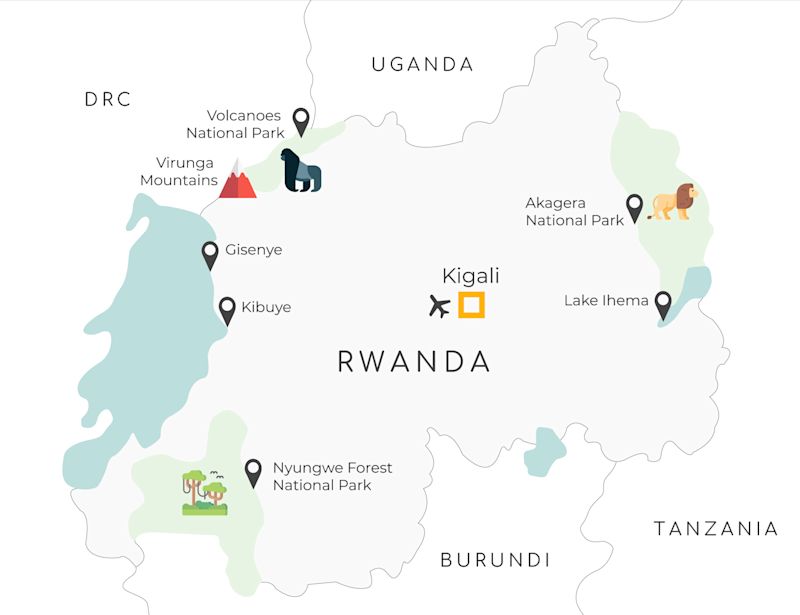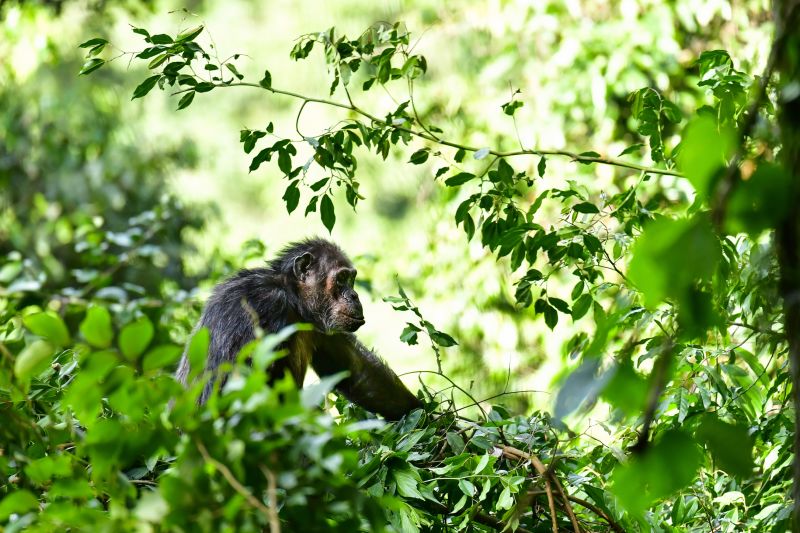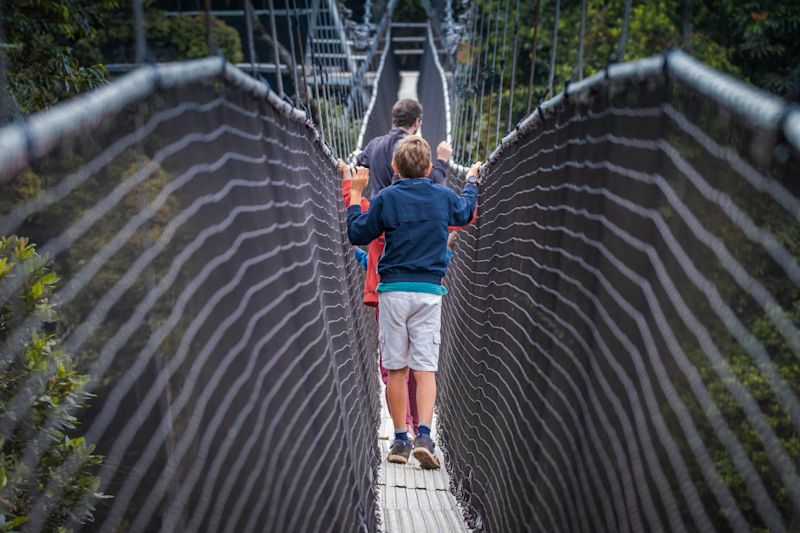There are five key destinations in Rwanda that you don't want to miss:
- Volcanoes National Park
- Lake Kivu
- Nyungwe Forest
- Akagera National Park
- City of Kigali
Map showing Rwanda's top destinations
Let's now look at the very best things to do in each of these destinations. It's a truly diverse list that includes unforgettable wildlife encounters like gorilla trekking, breathtaking scenery like a canopy treetop walk, culturally immersive activities like making banana beer, and moving experiences like visiting the Kigali Genocide Memorial.
VOLCANOES NATIONAL PARK
Volcanoes National Park lies within the Virunga Mountains
Volcanoes National Park is Rwanda's flagship reserve. This is because it's home to its endangered mountain gorilla population. It's also home to other important primates, like endangered golden monkeys. And it's a great place for hiking, as it contains a series of picturesque volcanic peaks that form part of the Albertine Rift Valley. It's the perfect destination for animal lovers and adventure seekers!
Gorilla trekking
A fully grown mountain gorilla in Volcanoes NP
Gorilla trekking (or gorilla tracking) is a thrilling wildlife encounter that involves hiking up into thick mountain jungle to find and spend time with a mountain gorilla troop.
It's a truly special experience to sit quietly for an hour with a gorilla troop. You can observe and photograph these gentle creatures as they groom themselves, munch of fruits, bamboo and other vegetation, and play. The gorillas you visit are accustomed to humans, so you can often sit just a few metres away from them.
The hike to and from the troop is also very rewarding, as you walk through wild, tangled rainforest that's alive with birdsong and the hum of insects. To learn more, please read 20 things to know about mountain gorilla trekking.
Golden monkey trekking
A golden monkey spotted in Volcanoes National Park
Much less known than the mountain gorilla is the golden monkey, another endangered primate and one that lives exclusively within the Virunga Mountains.
Golden monkeys are sociable creatures that live in troops ranging from three to 60 individuals. The monkeys' beautiful, brightly coloured fur makes them highly photogenic subjects.
Similarly to gorilla trekking, golden monkey trekking involves going on a hike to find and spend time with a troop. These hikes do, however, tend to be shorter and easier, as golden monkeys can usually be found at slightly lower elevations than mountain gorillas, often within bamboo forest. For this reason, a golden monkey trek is a good precursor to a mountain gorilla trek as it helps you to acclimatise to the high altitude of Volcanoes National Park.
For more detail, please read Do a beautiful forest hike to see endangered golden monkeys.
Mount Bisoke hike
Mt Bisoke is an active volcano
Mt Bisoke (also spelled Visoke) is an active volcano on the western edge of Volcanoes National Park. Like the other mountains in the Virunga range, its lower slopes are covered in rainforest and its upper slopes in pretty giant heather.
Mt Bisoke offers a great day hike of about five to seven hours, most of which are naturally spent on the uphill climb. So you need to be reasonably fit to manage the hike comfortably. Rewardingly, there's a crater lake fringed with thick vegetation to enjoy at the summit.
Note that you can also visit Dian Fossey's gravesite before or after your hike, as she's buried alongside some of her beloved gorillas, including Digit, in the grounds of Karisoke Research Centre at the base of Mt Bisoke.
NYUNGWE FOREST NATIONAL PARK
The undulating canopy of Nyungwe Forest
Nyungwe National Park is another of Rwanda's top attractions. It protects one of Africa's highest and most ancient high-altitude forests, as well as some grasslands, wetlands and bamboo forest.
The park is a naturalist's dream destination, as here you can find various Old World primates as well as hundreds of bird species and various endemic plants. The park is also home to the head waters of the Rukarara River, one of the contenders for being the source of the Nile.
Chimpanzee trekking
Chimps live in troops of around 20 to 100
Chimp trekking (or chimp tracking) is similar to gorilla trekking in its setup insomuch as you go on a guided hike into the forest to find a troop and spend time in their company.
Chimps spend time both on the ground and in trees. If you locate them when they're stationary, you can sit down to observe them playing, feeding and grooming themselves. If your troop is on the move, however, you might need to walk or jog to keep pace with them!
Please note that Nyungwe Forest National Park is between 1,600 and 2,950 m above sea level, so depending where your assigned troop is on the day, you might need to climb high, and you could feel the effects of the high altitude.
Treetop walkway
The treetop walkway in Nyungwe Forest
The most unique selling point of Nyungwe Forest National Park is undoubtedly its treetop canopy bridge. This 160-long walkway, which at its highest point is 70 m above the ground, offers visitors a sublime bird's-eye-view of the dense forest canopy spread across the park's endless hills. From your high vantage point, you have a good chance of spotting various birds and butterflies, as well as possibly some primates.
Nyungwe Forest is actually home to 13 primate species. These include olive baboons, grey-cheeked mangabeys, black-and-white colobus monkeys, l'Hoest's monkeys, red-tailed monkeys, owl-faced monkeys, golden monkeys, Dent's mona monkeys, crowned monkeys and Rwenzori colobus monkeys.
Nature hike
There are wonderful hiking routes within Nyungwe
There are many hikes of varying lengths and difficulty that you can do within Nyungwe Forest National Park, from one-hour jaunts to three-day treks.
For instance, there's the steep 7 km Bigugu Trail, which leads you up to Bigugu Peak (2,950 m) and takes about six hours. On this hike you can hope to spot red-collared babblers as well as various orchids and East Africa's iconic giant lobelias.
The Ngabwe Trail is a great eight-hour day hike for anyone keen to spot various primates, as they're often sighted on this route. Then there's also the Isumo Waterfall Trail, the Karamba Birding Trail, and the Source of the Nile Trail, among others.
Guided birding walk
A Rwenzori turaco spotted in Nyungwe Forest
About 322 bird species have been recorded in Nyungwe Forest National Park, including 29 Albertine Rift endemics. We highly recommend going on a guided birding walk to find and identify as many species as possible.
Some very rare species that draw birders to Nyungwe Forest from around the world include the Kungwe apalis, Kivu (or Abyssinian) ground thrush, Willard’s sooty boubou, Rockefeller’s sunbird, Congo Bay owl and Albertine owlet.
Other bird species found in the park that visitors often spy are the Rwenzori turaco, handsome francolin, Rwenzori nightjar, blue-headed sunbird, purple-breasted sunbird, Grauer’s swamp warbler and Neumann’s warbler.
LAKE KIVU
A man paddles in a traditional wooden canoe on Lake Kivu
The enormous Lake Kivu forms the entire western border of Rwanda, separating it from the DRC on the other side. It's a very attractive lake, being dotted with islands and fringed with thick vegetation as well as farms growing crops like bananas, guavas, tea and coffee.
The beach resort-style city of Kibuye halfway down the eastern shore is a great place to overnight when heading south from Volcanoes National Park to Nyungwe National Park as it breaks up the drive nicely.
Boat tour
Lake Kivu has 250 islands
A highlight of visiting Lake Kivu is going on the water.
There are boat tours available at various locations, and your guide will share fascinating facts and stories about the lake's history and communities. But the main pull of a boat outing is simply enjoying the fresh air and admiring the views of the islets, the mainland's beaches, villages and farms, and the comings and goings of local fishermen and traders.
If you'd like the option of stepping out onto a beach or two if the whim takes you, then you could instead hire a kayak. There are many beautiful coves to discover all along the lakeshore, like Manazi Cove near the city of Gisenye.
Banana, coffee or tea tour
Rwandan coffee is esteemed around the world
Many of Lake Kivu's farmers have realised that they can offer the curious traveller wonderful ecotourism experiences. Chief among these offerings, perhaps, is learning how to make banana beer!
Bananas are big business in Rwanda. In fact, the UN estimates there are 1.4 million smallholder banana growers in the country! And huge quantities of those bananas are used to make the country's most popular and strongest local beer. On a banana brewery tour you take part in the entire beer-making process, starting in the plantation and usually ending with a stroll into the village to clink banana beer glasses with some locals.
If coffee is more your vibe, know that coffee farm visits are another great ecotourism activity in the region. According to the SDC, there are around 450,000 small coffee farmers in Rwanda. Most coffee tours take place in the northern Lake Kivu region near Gisenyi.
Alternatively, we recommend going on a tea plantation tour. The crop was only introduced into Rwanda in 1952 but is now one of its biggest exports. Tea is mostly grown on large plantations, and the two most popular estates among visitors – Gisakura Tea Estate and Gisovu Tea Estate – are in the south near Nyungwe Forest.
AKAGERA NATIONAL PARK
Zebras and elands in Akagera National Park
You can't come to Rwanda and miss the opportunity for a safari. That would be a travesty.
Akagera National Park in the northeast is the country's best destination for a big-game safari and as such one of Rwanda's top tourist attractions. The park covers 1,233 square kilometres of hilly woodlands, savannah, wetlands and lakes, and has a great range of wildlife. It's also a world-class birding destination!
Safari drive
A lion resting in Akagera's Mohana Plain
Akagera National Park is home to various large mammals, including lions, elephants, buffaloes, leopards, giraffes, zebras, warthogs, tsessebes, Cape elands, topis, oribis and roan antelopes. Moreover, in recent years, black rhinos from South Africa and Czechia were reintroduced into Rwanda at Akagera National Park. This is an exciting development, both from an ecology point of view and a marketing one, as Akagera can now claim to once again host the Big Five.
We recommend going on a night-time safari drive in Akagera as well a daytime one. This will increase your chances of seeing crepuscular and nocturnal wildlife like leopards, hyenas, bush babies and civets. It also means you're more likely to see lions in action (versus having a snooze).
Birding safari
Akagera is an absolute must for birders
Akagera National Park has over 520 bird species. If you know your birds, then you know that that's a staggering figure! Moreover, a hundred of these species can only be seen in Akagera. This is why the park is on our list of the Top 9 East African destinations for birders.
Some striking birds to look for in Akagera include the much-admired shoebill stork, the African grey hornbill and the bare-faced go-away-bird. Some beauties to look for include the pin-tailed whydah, grey-backed fiscal, purple-crested turaco and blue-naped mousebird.
There are also various raptors to find, like African fish eagles, long-crested eagles and white-backed vultures. And then there are lovely migrant species like the lesser kestrel, long-tailed cistola, Arnot chat, Suoza shrike and great snipe.
One of the best ways to spot birds in the park is to go on a guided forest walk. Another great option is a boat safari on Lake Ihema ...
Lake Ihema boat safari
A bloat of hippos spotted in Lake Ihema
A boating safari is a wholly different experience from a safari drive, giving you a different perspective of the land and also letting you draw closer to certain animals.
Some of Akagera's famous residents that you can hope to spot in the water, among the reeds or on the shore include elephants, hippos, crocodiles, sitatungas and reedbucks.
As to waterbirds, Akagera plays host to several standout species like the aforementioned shoebill stork as well as the African jacana, Goliath heron, purple heron and papyrus gonolek. It also supports a whopping 267 African darter species, 366 great cormorant species, and 79 long-tailed cormorant species.
KIGALI
Dusk settles over Kigali
Kigali is Rwanda's burgeoning capital city, known for its cleanliness, pioneering tech industry, exciting cuisine, and avant-garde art and fashion. Nowhere else in the country do you have such a clear portrayal of the almost miraculous recovery and reimagining of a national identity.
Kigali Genocide Memorial
Entrance to the Genocide Memorial Centre
The Rwandan Genocide of 1994 was one of the great tragedies of modern times. The Kigali Genocide Memorial isn't, therefore, the sort of site that a visitor might skip towards. But as articulated by the memorial's website, "Everything starts with remembrance". And so for the visitor who wishes to understand this country and its people, such a site is an important starting point.
That said, the focus of the Kigali memorial is not only remembrance of the hundreds of thousands of murdered Tutsis, but also trauma healing and peace education. We naturally encourage you to join a guided tour to truly benefit from the experience.
The design scene
A sculpture by Cedric Misero that was displayed at the Kigali Triennial 2024
Kigali's overall design aesthetic is a unique and bold mixing of traditional and modern influences. You can see it in the architecture, in artworks, in household goods and in jewellery and fashion. For instance, the simple and bold geometric designs of the Rwandan imigongo tradition can be seen in building colours, in basket designs and in fabric prints, but with the update of bright, contrasting colours.
Kigali is also a great place to witness the reinvigoration of Rwanda's weaving and beading traditions, handicrafts historically passed down from mothers to daughters. Today you can find small-scale cooperatives making and selling handmade sisal storage baskets like in days of yore as well as haute-couture clothing from internationally acclaimed fashion designers. Visitors can therefore enjoy supporting the efforts of grassroots organisations or engaging in some high-end shopping.
For art lovers, we highly recommend visiting one or more of Kigali's stellar galleries. Of particular note are the Inema Art Centre, the Kigali Art Gallery and the Niyo Art Gallery, where you can appreciate the visual artworks as well as enjoy some music and performance-based arts.
Is it time to plan your visit?
That's it for our list of the top things to do in Rwanda. We trust we've whetted your appetite!
If you're ready to plan your visit to this beautiful and diverse country, please check out our exciting Rwanda holiday packages. Don't see exactly what you want? No worries, we can tailor your trip to your needs and preferences! Or if you'd like to simply learn more about the best things to do and see in the country, or when is the best time of year to visit, then check out our Rwanda travel blog.























